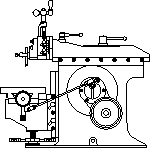

Ron Carroll from Clearmont, Missouri recently started up his South Bend shaper for the first time. I think we can all relate to his story.
“I am a newbie to using a shaper, even though I have been accumulating for years. Retirement, time and space are finally lining up to allow for some enjoyment of the accumulation.
So, today, 28-Feb-2003, I decided to see if I could make chips with the South Bend 7". I have read the manual, followed discussions on the web http://groups.yahoo.com/group/Metal_Shaperswatched a video, and generally educated myself way beyond reason.
The first thing that I noticed was I couldn't get the cutting tool to adjust to a steady height. It was either too high or too low, hitting the work and jamming the shaper. I gave my first attention to the drive system and found a loose set-screw in the large pulley on the motor drive side. Also, a belt was a little slack. I tightened the screw and applied some belt dressing. That had the effect of allowing the tool to smack the side of the work with much more vigor.
When it was cutting, the vise was rocking a little. I stopped and tightened the bolt that holds the vise. The rocking stopped but the tool height adjustment was still problematic, either too shallow or smacking the side of the work.
When I brought home the shaper, the clapper was locked with a set screw. Loosening the set-screw and spraying with Gibbs allowed the clapper to swing. I noticed that he clapper was not seating all the way down. When the tool hit the work, the clapper dug in and seated. That was the cause of the height adjustment difficulty.
Spraying with more Gibbs didn't help. So, I drove out the tapered hinge pin and examined the sides of the clapper. They still have the grinding marks South Bend put on them in manufacturing but no signs of any wear. After spraying, wiping, and cleaning, it was s till tight. So, I took the risk of honing a little metal off the sides of the clapper with my diamond knife sharpening tool. It only took a few strokes on each side and the clapper was swinging freely.
I then reassembled and cranked it up and wow! It adjusts and it holds adjustment all the way across the work piece. Will it go faster? I moved it progressively from its slowest to its fastest speed. The chips do smoke when jumping off the work. Neat!

South Bend Shaper
photo by Ron Carroll
I sprayed and generally made a lubricated mess of the shaper before cranking it up. While it was running, I could see that it was pumping oil up onto the ways. They will never wear, as they are flooded. So flooded that oil was running down one side of the shaper. I cleaned out the little channels at the ends of the ways so oil can return to the inside and that helped, but it was still pumping more than it needs. I will read the manual and adjust it later.
Next, I need to find some bolts to fit into the stand adjustment so the shaper can rest on them rather than the caster wheels as it does dance a little on the highest speed. Also, drain the oil, clean the bottom of the oil reservoir, and refill with the proper oil. I have one quart of South Bend oil from Blue Ridge Supply and am looking for more.
Finally, I removed the piece of steel that the shaper had been chewing on and took it to the bench. The finish was slightly rough. A few s trokes of the aforementioned diamond stone brought out a smooth, almost polished finish. I think some attention to tool grinding and cutting fluid will work wonders.
While sitting and watching the South Bend make its cuts, I gave thought to magnetically mounting two micro switches, one at either end of the table travel, to serve as limit switches so that the s haper can work on its own, stopping after each travel. It won't take much of a switch, as the motor is only 1/2 HP.”
Thanks for that story, Ron.
Keep sending me email with questions and interesting shaper stories.
My email address is KayPatFisher@gmail.com.